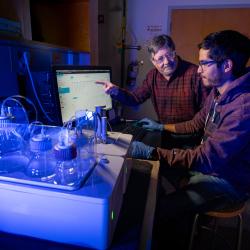UMD Chemistry and Biochemistry’s YuHuang Wang Receives Kirwan Faculty Research and Scholarship Prize
The award recognizes Wang’s research in fundamental chemistry and advanced materials, which led to development of a textile that automatically regulates heat exchange with the environment
University of Maryland Chemistry and Biochemistry Professor YuHuang Wang will receive the 2019 Kirwan Faculty Research and Scholarship Prize at the university’s Faculty and Staff Convocation on September 18, 2019. The prize, which provides a $5,000 stipend, recognizes a faculty member for a highly significant work of research, scholarship or artistic creativity completed within the last three years.
“Professor Wang’s research has led to the development of new materials with real potential to make important contributions to society,” said Amitabh Varshney, dean of UMD’s College of Computer, Mathematical, and Natural Sciences. “This award recognizes his creative work developing a fabric that responds to temperature and humidity by changing the amount of heat passing through it. We are very pleased to have him as a member of our faculty.”
The Kirwan Research and Scholarship Prize was established in honor of UMD Mathematics Professor and Former UMD President William E. Kirwan and his late wife, Patricia Kirwan. Wang is only the second faculty member from the Department of Chemistry and Biochemistry to receive this annual award. Millard Alexander received the inaugural prize in 1999.
“I am deeply honored,” Wang said. “It is fantastic to be recognized by such a prestigious award, and I hope to live up to the high expectations set by my distinguished colleagues. In many ways, this is recognition of my hardworking and creative students, postdocs, collaborators, and many truly remarkable people who have contributed to the work.”
Wang began exploring the idea of a new type of textile a few years ago when the U.S. Department of Energy’s (DOE) Advanced Research Projects Agency-Energy, ARPA-E, challenged U.S. researchers to increase energy efficiency in large buildings.
“I was looking at the blinds in my office window when it occurred to me that such a tunable function could make a difference in clothing and directly respond to this challenge,” Wang explained. “We have been heating and cooling entire buildings, but what if we could focus on just the space around each individual?”
Wang’s solution was a fabric that could automatically adjust its radiative and insulative properties in response to temperature and humidity. His project team focused on engineering a special yarn consisting of carbon nanotube-coated fibers. Under hot, humid conditions, the fibers warp and the strands of yarn compact, which opens microscopic pores in the fabric and allows more heat to pass through. What’s more, as the yarn compacts, the distance between carbon nanotubes changes in a way that amplifies the infrared radiation, or heat, escaping from the fabric. The end result is that the fabric acts as a tunable blind to transmit or block heat.
Wang and his colleagues described their discovery in the February 8, 2019, issue of the journal Science. The work received immediate global attention and was featured in dozens of media articles including international coverage from the BBC, NBC, The Washington Post, Scientific American, MIT Technology Review, Gizmodo, Fast Company, DeZeen, Italy’s la Repubblica and many others. The fabric also drew attention from corporations and individuals interested in using the technology for performance sportswear and medical and military applications.
"YuHuang has been extremely innovative and absolutely relentless in developing new carbon-based materials with transformative properties," said Janice Reutt-Robey, professor and chair of the Department of Chemistry and Biochemistry at UMD. "He is working at the frontier of chemical sciences in creating highly functional carbon materials, and the Kirwan Faculty Research and Scholarship Prize is well-earned recognition for his bold approach and exceptional scientific rigor.”
Wang, who came to UMD in the fall of 2008, grew up in China and earned his B.S. in chemistry from Xiamen University. Inspired by the work of the late Nobel laureate Richard E. Smalley, Wang moved to the U.S. where he received his Ph.D. in chemistry from Rice University under the guidance of Smalley. He did his postdoctoral research on molecular printing with Chad Mirkin at Northwestern University before joining UMD.
At UMD, Wang’s research has focused on a series of fundamental questions with ambitious goals of opening new paths in energy, biomedicine and quantum technologies. His team synthetically created new classes of functional materials—including organic color-centers and tube-in-a-tube semiconductors—and developed a suite of tools to explore their fundamental chemistry and physics as well as applications.
Wang won a National Science Foundation (NSF) Faculty Early Career Development (CAREER) award in 2011 and currently leads an NSF-funded team project to develop a new source of single photons that may help advance quantum research and technology.
Wang also serves as deputy scientific director of the Center for Enhanced Nanofluidic Transport (CENT). An Energy Frontier Research Center funded by DOE’s Basic Energy Sciences program, CENT brings scientists from a range of disciplines together to collaborate on fundamental studies of fluidic flow and molecular transport with the goal of establishing the scientific foundation for new water purification and chemical separation technologies.
“The development of a new fabric is a bit of an unusual and unexpected direction for my work,” Wang said. “I hadn’t anticipated that my team’s research in materials chemistry and energy would lead down this path, but looking back, it’s all natural. We have been studying fundamental materials properties and light-matter interactions for nearly a decade now, and carbon nanotubes, one of the materials that we have intensively studied, are tiny fibers after all.”
Wang has been pleasantly surprised by the outpouring of interest in his work.
“I have received so many emails and phone calls from people interested in this work,” Wang said. “As a researcher, it is particularly rewarding that fundamental studies can find their way into applications that directly touch people’s lives and may potentially make a difference.”
Wang and his colleagues are now working to develop a commercially marketable version of the fabric.
“The university has been very supportive in this regard,” Wang said. “The university’s Office of Technology Commercialization has offered guidance and made connections to the industry and potential partners. In addition, we’ve been continually supported by ARPA-E and the Maryland Innovation Initiative in our efforts to scale up this technology. It is truly a collaborative effort, and I am grateful for everyone who has contributed.”
###
Writer: Kimbra Cutlip
Media Relations Contact: Abby Robinson, 301-405-5845, abbyr@umd.edu
University of Maryland
College of Computer, Mathematical, and Natural Sciences
2300 Symons Hall
College Park, Md. 20742
www.cmns.umd.edu
@UMDscience
About the College of Computer, Mathematical, and Natural Sciences
The College of Computer, Mathematical, and Natural Sciences at the University of Maryland educates more than 9,000 future scientific leaders in its undergraduate and graduate programs each year. The college's 10 departments and more than a dozen interdisciplinary research centers foster scientific discovery with annual sponsored research funding exceeding $175 million.








